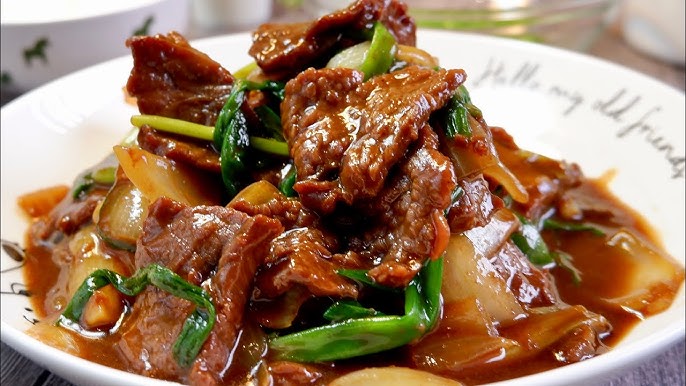Easy Stir Fry Recipe: Stir frying is a classic cooking technique that originated in China and has since taken over kitchens worldwide. At its core, it’s a fast and fiery method of cooking food in a hot pan—usually a wok—using a small amount of oil. What makes stir frying so appealing is its simplicity and speed. Within minutes, you can have a hot, flavorful meal that’s packed with nutrients.
Stir frying typically involves cooking bite-sized ingredients quickly over high heat while constantly stirring. This method locks in flavor and maintains the texture of the ingredients, especially the crunch of the veggies. It’s a technique that works perfectly for busy weeknights when you want something delicious but don’t have hours to spend in the kitchen.
Why Stir Frying Is So Popular
There are a few solid reasons why stir frying is a kitchen favorite. First off, it’s incredibly versatile. You can toss in whatever veggies, protein, and sauces you have on hand and end up with a tasty dish. It’s also super healthy because you use minimal oil and retain more nutrients compared to boiling or deep frying.
Plus, stir frying is budget-friendly. You don’t need fancy ingredients or expensive tools. It’s a one-pan meal that reduces cleanup time and helps you eat better without breaking the bank. Whether you’re a beginner cook or a seasoned home chef, stir frying is a technique that belongs in your culinary toolkit.
Essential Ingredients for a Perfect Stir Fry
Choosing the Right Vegetables
Not all veggies are created equal when it comes to stir frying. The best ones hold up well to high heat and cook quickly. Think of vegetables like bell peppers, broccoli, carrots, snap peas, zucchini, mushrooms, and baby corn. These not only bring vibrant colors to your plate but also offer a satisfying crunch.
The key is to chop everything into similar sizes. This helps the veggies cook evenly and keeps them from getting mushy. You also want to think about the order in which you cook them—harder veggies like carrots and broccoli should go in first, while softer ones like mushrooms and spinach should be added last.
Want to boost your stir fry even more? Add in aromatics like garlic, ginger, and onions. They pack a flavor punch and elevate your dish from basic to restaurant-quality in no time.
Best Protein Options for Stir Fry
Protein is a must in any stir fry—it’s what makes the dish filling and satisfying. You’ve got a ton of options here. Chicken, beef, shrimp, pork, tofu, and even tempeh are all great choices. Just make sure to cut the protein into bite-sized pieces so it cooks evenly and quickly.
Marinating your protein beforehand can make a huge difference. A simple mix of soy sauce, garlic, ginger, and a splash of sesame oil can infuse your meat or tofu with loads of flavor. Don’t skip this step if you want a stir fry that truly pops.
Must-Have Sauces and Seasonings
This is where the magic happens. A good sauce ties the whole dish together and takes it from decent to downright irresistible. Here are some staples to keep on hand:
- Soy Sauce: Salty and savory, it’s the base of most stir fry sauces.
- Oyster Sauce: Adds depth and a hint of sweetness.
- Hoisin Sauce: A rich, sweet-savory sauce that’s perfect for bolder flavor.
- Sesame Oil: Adds a toasty finish—use it sparingly.
- Rice Vinegar or Lime Juice: For a little tang and balance.
- Cornstarch Slurry: Helps thicken your sauce so it clings to the ingredients.
Mix and match these to create a custom stir fry sauce that hits all the right notes—sweet, salty, tangy, and umami.
Tools You’ll Need for Stir Frying
Wok vs. Skillet: What’s Better?
The traditional tool for stir frying is a wok—and for good reason. Its high, sloped sides make it ideal for tossing ingredients without spilling, and it distributes heat evenly. If you’ve got one, use it.
But don’t worry if you don’t have a wok. A large, deep skillet can get the job done just fine, especially if it’s non-stick or stainless steel. Just make sure it can handle high heat without warping.
Other Kitchen Essentials
Besides a wok or skillet, here’s what you’ll need:
- Sharp Knife: For slicing your ingredients quickly and safely.
- Cutting Board: Preferably one each for meat and veggies to avoid cross-contamination.
- Tongs or Wooden Spoon: For tossing ingredients easily.
- Mixing Bowls: To organize prepped ingredients before cooking.
- Measuring Spoons: So you get your sauce just right.
Having everything ready before you start cooking—what chefs call “mise en place”—makes the process smooth and stress-free.
Step-by-Step Stir Fry Recipe
Step 1: Prepping Your Ingredients
Preparation is everything in stir frying. Because the cooking process moves so fast, you don’t want to be chopping veggies or mixing sauces while your food is already on the heat. Start by washing and drying all your vegetables thoroughly. Then chop them into uniform, bite-sized pieces. This ensures even cooking and gives your stir fry a professional look.
For proteins like chicken, beef, or tofu, slice them thinly so they cook quickly. If you’re using meat, marinate it at least 15–20 minutes beforehand in a simple mix of soy sauce, garlic, a pinch of sugar, and cornstarch. This not only flavors the meat but also helps keep it juicy during cooking.
Lastly, whip up your sauce. You can pre-mix a combination of soy sauce, oyster sauce, hoisin, rice vinegar, and a bit of cornstarch slurry in a small bowl. Keep it handy—you’ll be pouring it in quickly once everything’s in the pan.
Step 2: Cooking Your Protein
Once everything is prepped, heat your wok or skillet over high heat. Add a tablespoon of oil—canola, vegetable, or peanut oil work best because they can handle high temperatures without burning.
When the oil starts to shimmer, add your protein. Spread it out in the pan and let it sear for a minute before stirring. This helps get that beautiful caramelized exterior that locks in flavor. Stir and cook the protein until it’s just done—don’t overcook, as it will continue to cook slightly when mixed with the veggies and sauce later on.
Once it’s cooked through, transfer it to a clean plate and set it aside. This keeps it from overcooking and getting dry while you stir fry the rest of the ingredients.
Step 3: Stir Frying the Vegetables
Add a bit more oil if needed, then throw in your harder vegetables like carrots and broccoli first. Stir them around for about 1–2 minutes until they start to soften slightly. Next, add medium-firm veggies like bell peppers, mushrooms, or zucchini.
Save the more delicate ingredients like leafy greens, bean sprouts, or snow peas for last. They only need about 30 seconds in the pan to cook through. The idea is to keep everything crisp-tender—not soggy. Stir constantly to ensure even heat distribution and to keep things from sticking or burning.
If you’re using aromatics like garlic or ginger, now’s the time to toss them in. Stir for about 30 seconds until fragrant.
Step 4: Mixing Everything Together
Now comes the fun part—bringing everything together. Add your cooked protein back into the pan with the veggies. Give it a good toss to combine.
Pour in your pre-mixed sauce. Stir continuously so the sauce evenly coats all the ingredients. The cornstarch in the sauce will help it thicken and cling beautifully to the meat and veggies, creating that glossy, mouthwatering finish that makes stir fry so addictive.
Let everything simmer together for 1–2 minutes, just until the sauce thickens and the flavors marry. Taste and adjust the seasoning if needed—maybe a splash more soy sauce or a sprinkle of chili flakes for heat.
Step 5: Serving Suggestions
Serve your stir fry hot, straight from the pan. It pairs wonderfully with freshly steamed rice or noodles. If you want to keep it low-carb, try it over cauliflower rice or a bed of shredded cabbage.
Top it off with a few extras to make it restaurant-worthy:
- Toasted sesame seeds
- Chopped green onions
- A squeeze of lime
- A drizzle of sriracha or chili oil for spice
This dish is best enjoyed immediately while everything is still crisp and piping hot.
Pro Tips for Making the Best Stir Fry
How to Keep Your Veggies Crispy
The secret to perfectly crisp veggies in stir fry is high heat and speed. Make sure your wok is hot before adding anything. If the pan isn’t hot enough, your vegetables will steam rather than fry, resulting in a soggy texture.
Also, don’t overcrowd the pan. Cook in batches if needed, especially if you’re making a large quantity. Overcrowding drops the temperature and leads to uneven cooking.
Lastly, avoid adding too much sauce. A little goes a long way. You want the ingredients to be coated, not swimming in liquid. This helps keep that delightful crispiness intact.
Common Mistakes to Avoid
Even though stir frying is simple, there are a few mistakes that can throw off your game:
- Starting with a cold pan – Always preheat your wok before adding oil or ingredients.
- Overcooking the protein – Take it out once it’s done and add it back at the end.
- Using the wrong oil – Stick to oils with a high smoke point. Olive oil is not ideal here.
- Not prepping in advance – Stir frying moves fast; have everything chopped and ready.
- Skipping the cornstarch – It’s the secret to that glossy, thick sauce texture.
Keep these in mind, and your stir fry will come out perfectly every time.
FAQs about Easy Stir Fry Recipe
1. What is the secret to a good stir fry?
The secret lies in high heat, a hot wok or skillet, fresh ingredients, and prepping everything in advance. Stir quickly and don’t overcrowd the pan to keep things crispy.
2. Can I use frozen vegetables in stir fry?
Yes! Just thaw and pat them dry first. This helps avoid excess water and keeps your stir fry from getting soggy.
3. What oil is best for stir fry?
Use oils with a high smoke point like canola, peanut, or vegetable oil. They can handle the heat and give your stir fry that perfect sizzle.
4. How do I make my stir fry sauce taste better?
Balance is key—mix soy sauce, garlic, ginger, a bit of sugar or honey, and a splash of rice vinegar or sesame oil for a flavor-packed sauce.
5. Do I cook meat or vegetables first in a stir fry?
Always cook the meat first and set it aside. Then cook the vegetables and add the meat back in at the end to combine everything evenly.
6. Can I make stir fry ahead of time?
Stir fry is best fresh, but you can prep your ingredients and sauce ahead. Reheat leftovers quickly over high heat to keep them tasty.
Conclusion
What really makes stir fry stand out is how customizable it is. You’re not stuck with any one set of veggies or proteins—swap out chicken for shrimp, broccoli for snow peas, or make it entirely vegetarian. The real key is in your prep work and sauce. Get those right, and everything else falls into place.
Remember, the trick is to work quickly and confidently. Have all your ingredients chopped, sauces mixed, and tools ready before you start cooking. Stir fry waits for no one! Once you’ve mastered the basics, you can start experimenting with different spice blends, regional sauces, and unique protein choices.
So the next time you’re wondering what to cook for dinner, skip the takeout menu and go for a homemade stir fry. It’s healthy, affordable, and comes together in under 30 minutes. Plus, it’s a meal that always impresses, no matter who you’re serving.



